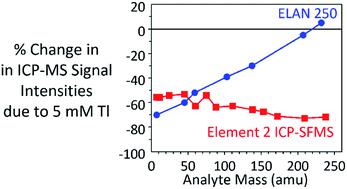当前位置:
X-MOL 学术
›
J. Anal. At. Spectrom.
›
论文详情
Our official English website, www.x-mol.net, welcomes your feedback! (Note: you will need to create a separate account there.)
Characterization of matrix effects using an inductively coupled plasma-sector field mass spectrometer
Journal of Analytical Atomic Spectrometry ( IF 3.4 ) Pub Date : 2020-08-03 , DOI: 10.1039/d0ja00207k Shi Jiao 1, 2, 3, 4, 5 , John W. Olesik 1, 2, 3, 4, 5
Journal of Analytical Atomic Spectrometry ( IF 3.4 ) Pub Date : 2020-08-03 , DOI: 10.1039/d0ja00207k Shi Jiao 1, 2, 3, 4, 5 , John W. Olesik 1, 2, 3, 4, 5
Affiliation

|
Matrix effects in ICP-MS are widely thought to be more severe for heavy matrix and light analyte elements due to space charge effects (ion repulsion following the formation of a positive beam downstream of the skimmer). It has been suggested that accelerating the ions downstream of the skimmer could possibly alleviate matrix effects by compensating for the kinetic energy differences between low and high mass ions. A sector field mass spectrometer (ICP-SFMS) which accelerates ions downstream of the skimmer using an extraction lens held at −2 kV, was used to comprehensively study matrix effects due to high concentrations of concomitant elements as a function of analyte mass, matrix mass, matrix element concentration, lens voltage, and nebulizer gas flow rate. The effects of matrix elements with a wide range of masses (Na, Cu, Y, In, Cs, Tb, Lu, and Tl) on analyte sensitivities with a wide mass range (7Li+, 11B+, 24Mg+, 45Sc+, 71Ga+, 75As+, 88Sr+, 111Cd+, 138Ba+, 153Eu+, 172Yb+, and 238U+) were characterized. The severity of matrix-induced changes in analyte sensitivities was similar for a single matrix element using the ICP-SFMS as those observed using an ICP-Quadrupole MS (ICP-QMS) which uses a single, low voltage positive ion lens. However, the ion beam current would be expected to be higher using the ICP-SFMS than using the ICP-QMS with a single positive ion lens due to the higher sensitivity provided by the ICP-SFMS (1 000 000 counts per s per ppb) versus the ICP-QMS used in this study (15 000 counts per s per ppb). Matrix effects using the ICP-SFMS for equimolar matrix element concentrations were more severe as the matrix element mass increased when a grounded guard electrode was used, while the analyte ion mass had little impact on the severity of matrix effects. When the guard electrode was ungrounded, the matrix effects were still not very dependent on analyte mass; the severity of the matrix effects was also not dependent on the matrix element mass. The lack of matrix severity dependence on analyte ion mass using ICP-SFMS, and recent reports using ICP-Quadrupole MS, is contrary to expectations if space charge effects were solely responsible for mass dependent matrix effects in ICP-MS.
中文翻译:

使用电感耦合等离子体扇区场质谱仪表征基质效应
ICP-MS中的基质效应由于空间电荷效应(在分离器下游形成正离子束而引起的离子排斥)被认为对于重质基质和轻质分析物元素而言更为严重。已经提出,通过补偿低质量离子和高质量离子之间的动能差,加速分离器下游的离子可以减轻基质效应。扇形场质谱仪(ICP-SFMS)使用保持在-2 kV的萃取透镜加速分离器下游的离子,用于全面研究基质效应,这是由于伴随元素的高浓度与分析物质量,基质质量有关,基质元素浓度,透镜电压和雾化器气体流速。质量范围广泛的基质元素(Na,Cu,Y,In,Cs,Tb,Lu,7 Li +, 11 B +, 24 Mg +, 45 Sc +, 71 Ga +, 75 As +, 88 Sr +, 111 Cd +, 138 Ba +, 153 Eu +, 172 Yb +和238 U +)的特征。对于使用ICP-SFMS的单个基质元素,基质诱导的分析物灵敏度变化的严重程度与使用单个低压正离子透镜的ICP-Quadrupole MS(ICP-QMS)观察到的相似。但是,由于ICP-SFMS提供更高的灵敏度(1 pp / s / ppb,1 000 000个计数/秒),使用ICP-SFMS的离子束电流将比使用带单个正离子透镜的ICP-QMS更高。与本研究中使用的ICP-QMS(每ppb每秒15 000个计数)。当使用接地保护电极时,随着基质元素质量的增加,对于等摩尔基质元素浓度,使用ICP-SFMS的基质效应更为严重,而分析物离子质量对基质效应的严重性影响很小。当保护电极未接地时,基体效应仍不非常依赖于分析物质量;基质效应的严重性也不取决于基质元素的质量。如果使用空间电荷效应仅对ICP-MS中质量相关的基质效应负责,则缺乏使用ICP-SFMS基质对分析物离子质量的严重性依赖性以及最近使用ICP-Quadrupole MS的报道。
更新日期:2020-09-02
中文翻译:

使用电感耦合等离子体扇区场质谱仪表征基质效应
ICP-MS中的基质效应由于空间电荷效应(在分离器下游形成正离子束而引起的离子排斥)被认为对于重质基质和轻质分析物元素而言更为严重。已经提出,通过补偿低质量离子和高质量离子之间的动能差,加速分离器下游的离子可以减轻基质效应。扇形场质谱仪(ICP-SFMS)使用保持在-2 kV的萃取透镜加速分离器下游的离子,用于全面研究基质效应,这是由于伴随元素的高浓度与分析物质量,基质质量有关,基质元素浓度,透镜电压和雾化器气体流速。质量范围广泛的基质元素(Na,Cu,Y,In,Cs,Tb,Lu,7 Li +, 11 B +, 24 Mg +, 45 Sc +, 71 Ga +, 75 As +, 88 Sr +, 111 Cd +, 138 Ba +, 153 Eu +, 172 Yb +和238 U +)的特征。对于使用ICP-SFMS的单个基质元素,基质诱导的分析物灵敏度变化的严重程度与使用单个低压正离子透镜的ICP-Quadrupole MS(ICP-QMS)观察到的相似。但是,由于ICP-SFMS提供更高的灵敏度(1 pp / s / ppb,1 000 000个计数/秒),使用ICP-SFMS的离子束电流将比使用带单个正离子透镜的ICP-QMS更高。与本研究中使用的ICP-QMS(每ppb每秒15 000个计数)。当使用接地保护电极时,随着基质元素质量的增加,对于等摩尔基质元素浓度,使用ICP-SFMS的基质效应更为严重,而分析物离子质量对基质效应的严重性影响很小。当保护电极未接地时,基体效应仍不非常依赖于分析物质量;基质效应的严重性也不取决于基质元素的质量。如果使用空间电荷效应仅对ICP-MS中质量相关的基质效应负责,则缺乏使用ICP-SFMS基质对分析物离子质量的严重性依赖性以及最近使用ICP-Quadrupole MS的报道。



























 京公网安备 11010802027423号
京公网安备 11010802027423号